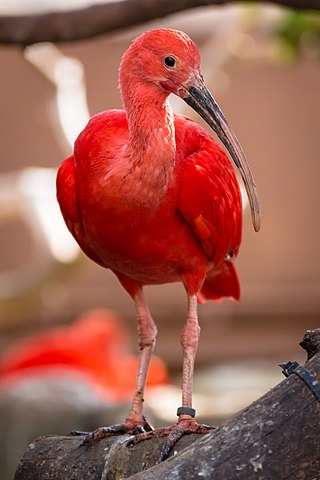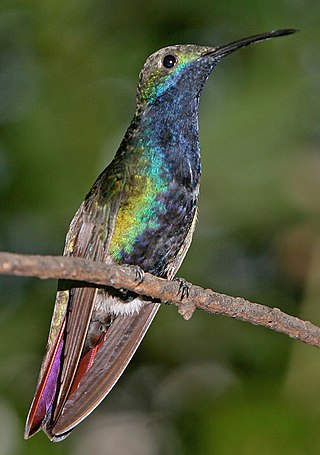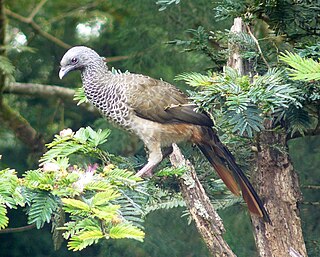
The scarlet ibis, sometimes called red ibis, is a species of ibis in the bird family Threskiornithidae. It inhabits tropical South America and part of the Caribbean. In form, it resembles most of the other twenty-seven extant species of ibis, but its remarkably brilliant scarlet coloration makes it unmistakable. It is one of the two national birds of Trinidad and Tobago, and its Tupi–Guarani name, guará, is part of the name of several municipalities along the coast of Brazil.

The chachalacas, guans, and curassows are birds in the family Cracidae. These are species of tropical and subtropical Central and South America. The range of one species, the plain chachalaca, just reaches southernmost parts of Texas in the United States. Two species, the Trinidad piping guan and the rufous-vented chachalaca occur on the islands of Trinidad and Tobago respectively.

The rufous-tailed jacamar is a near-passerine bird which breeds in the tropical New World in southern Mexico, Central America and South America as far south as southern Brazil and Ecuador.

The blue-backed manakin is a small passerine bird which breeds in tropical South America, its range extending from Colombia and Tobago to southeastern Brazil. It is found in deciduous forests but not evergreen rainforests. It is a small, plump bird about 13 centimetres (5 in) long. Males have black plumage with a bright blue back and a red or yellow crown. Females and juveniles are olive-green with paler underparts. At breeding time, males are involved in a cooperative lekking behaviour during which they jump and twirl. This is a fairly common species with a wide range, and the International Union for Conservation of Nature has rated its conservation status as being of "least concern".

The bat falcon is a bird of prey in the family Falconidae, the falcons and caracaras. It is found in Mexico, Central America, Trinidad, and every mainland South American country except Chile and Uruguay.

The black-throated mango is a species in subfamily Polytminae of the hummingbird family Trochilidae. It is found in Panama, in every mainland South American country except Chile, and in Trinidad and Tobago.

The rufous-breasted wren is a small songbird of the family Troglodytidae. It is found in Colombia, Costa Rica, Panama, Trinidad and Tobago, and Venezuela.

The rufous-breasted hermit or hairy hermit is a hummingbird that breeds from Panama south to Bolivia, and on Trinidad, Tobago and Grenada. It is a widespread and generally common species, though local populations may change in numbers and disappear altogether in marginal habitat.

The cocoa thrush is a resident breeding thrush in South America, from eastern Colombia south and east to central and eastern Brazil, as well as on the Caribbean island of Trinidad and some of the Lesser Antilles.

The chestnut woodpecker a species of bird in subfamily Picinae of the woodpecker family Picidae. It is found on Trinidad and in every mainland South American country except Argentina, Chile, Paraguay, and Uruguay.

The grey-headed chachalaca is a member of an ancient group of birds of the family Cracidae, which includes chachalacas, guans, and curassows. It is found from Honduras to Colombia.

The ruddy ground dove is a small New World tropical dove. It is a resident breeder from Mexico south to Brazil, Peru and Paraguay, and northern Argentina, and on Trinidad and Tobago. Individual birds can sometimes be seen in the southwestern USA, from southern Texas to southernmost California, primarily during winter.

The rufous-shafted woodstar is a species of hummingbird in tribe Mellisugini of subfamily Trochilinae, the "bee hummingbirds". It is found in Colombia, Trinidad and Tobago, and Venezuela.

The rufous-headed chachalaca is a species of bird in the family Cracidae, the chachalacas, guans, and curassows. It is found in Colombia, Ecuador, and Peru.

The chestnut-winged chachalaca is a species of bird in the family Cracidae, the chachalacas, guans, and curassows. It is endemic to Colombia.

The speckled chachalaca is a species of bird in the family Cracidae, the chachalacas, guans, and curassows. It is found in Bolivia, Brazil, Colombia, Ecuador, and Peru.

The West Mexican chachalaca is a species of bird in the family Cracidae, the chachalacas, guans, and curassows. It is endemic to Mexico.

The Trinidad euphonia is a species of bird in the family Fringillidae. It is common in northern Colombia and northern Venezuela and uncommon to rare on the Caribbean island of Trinidad. Like all euphonias, it is small, stocky, and short-tailed; unlike some, it is sexually dimorphic. The male is glossy blue-black on the head, back, throat, and upper breast, with a bright yellow forehead and crown, and bright yellow underparts. The female is olive-green above and yellow-olive below, with a grayer patch running down the center of her breast and abdomen, and bright yellow undertail coverts. Its calls are high-pitched, plaintive whistles: the two most common are a single-pitched, double-noted "pee pee" or "tee dee", or a rising, double-noted "puwee", "cooleee" or "duu dee". Its song is a short, jumbled mix of musical and nonmusical notes.

The rufous-tailed flatbill is a species of bird in the family Tyrannidae. It is found in Bolivia, Brazil, Colombia, Ecuador, French Guiana, Guyana, Peru, Suriname, and Venezuela. Its natural habitat is subtropical or tropical moist lowland forests.

The Colombian chachalaca is a species of bird in the family Cracidae. It is endemic to the forests and woodlands in the inter-Andean valleys in Colombia. Colombian Chachalacas are frugivorous and lead an arboreal lifestyle. The large seeds they disperse through defecation support the maintenance of diverse tropical forests.























